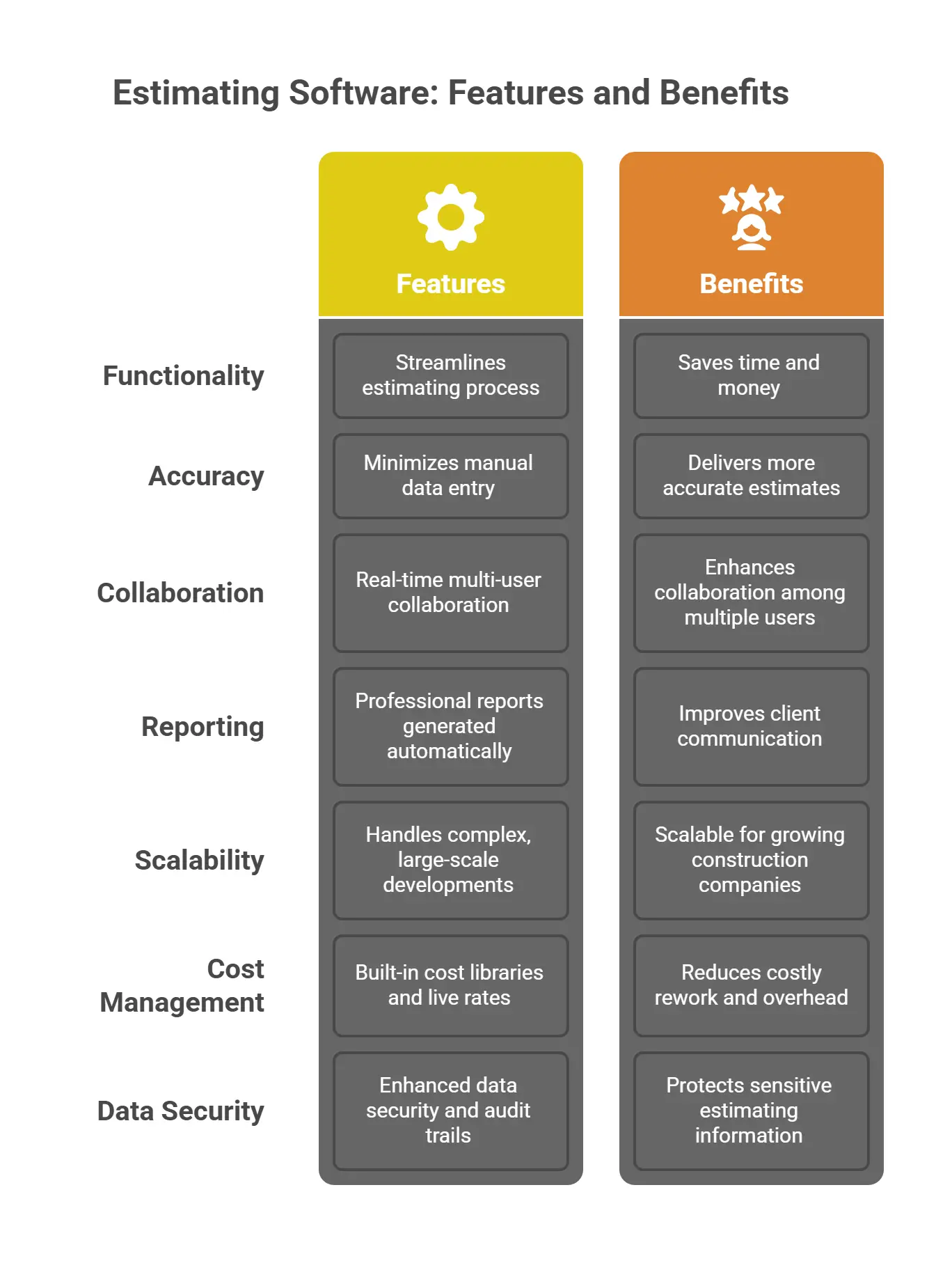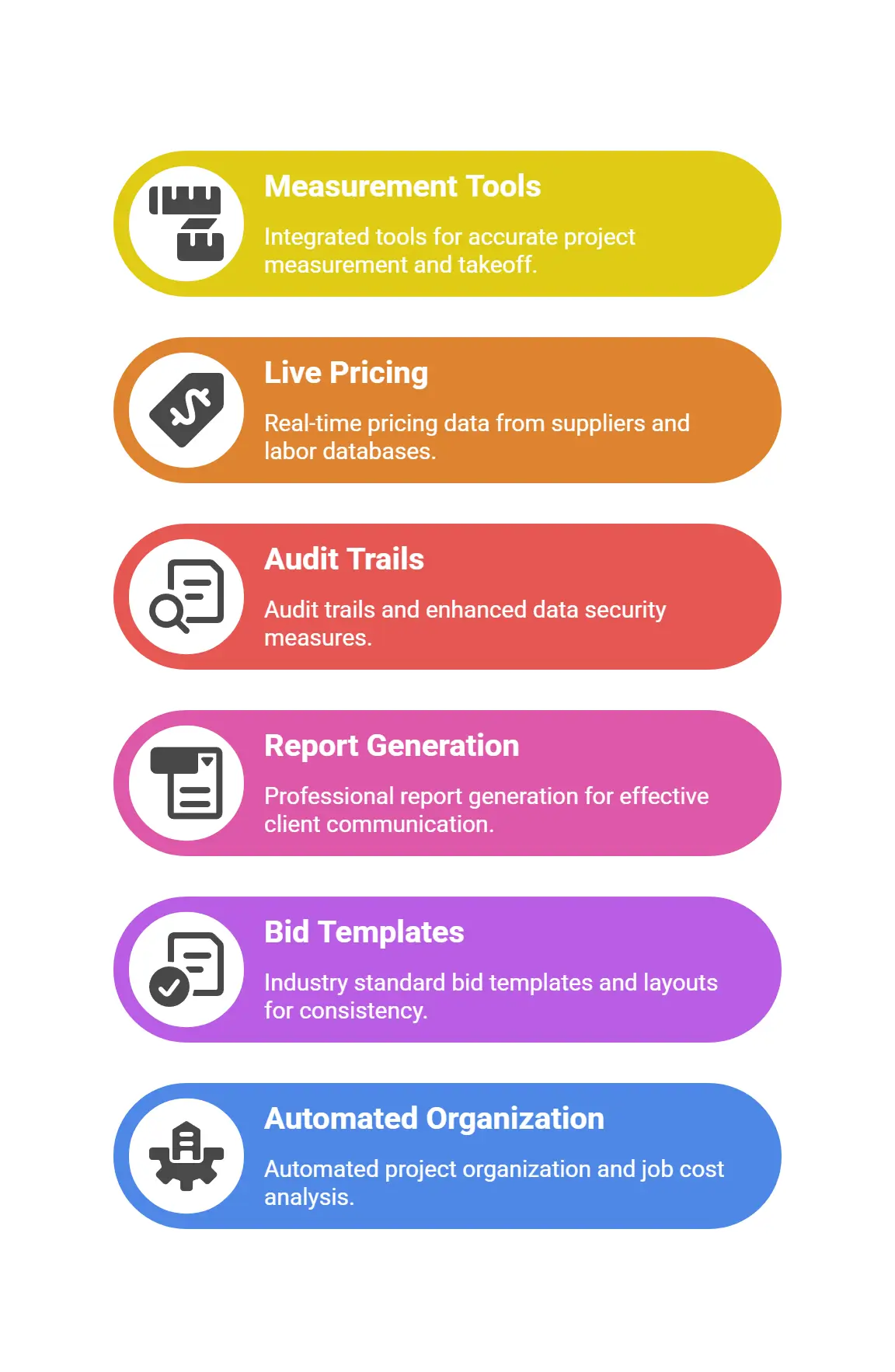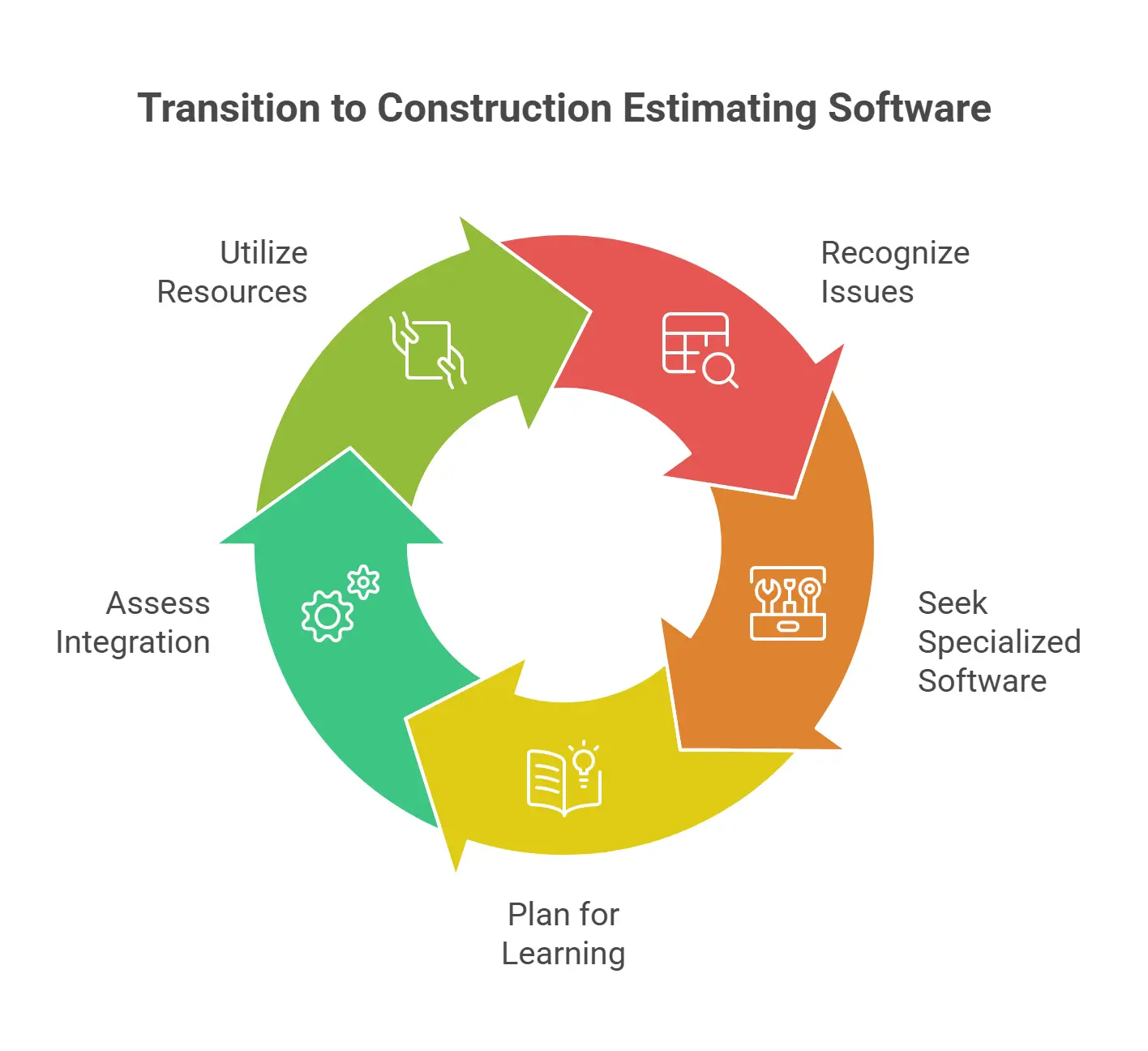

Excel vs Estimating Software: Which Is Best for Construction?
TL;DR: Microsoft Excel® works for small jobs, but when your projects get complicated, construction estimating software leaves it in the dust. Think faster bids, fewer mistakes, smoother teamwork, and easier scaling. For construction companies juggling complex work and chasing more accurate estimates, integrated solutions like CostOS can mean the difference between winning jobs and losing margins.
Excel vs Construction Estimating Software: Understanding the Key Differences
Users in the construction industry are constantly searching for the best ways to improve their project cost estimation process. The debate of Excel versus construction estimating software centers on delivering accurate estimates, saving time, and supporting collaboration. While Excel has been used for over 40 years in the construction business thanks to its low cost and familiar interface, it was not designed specifically for estimating. Dedicated construction estimation software provides purpose-built features and a real advantage for modern projects.
The Role of Estimating in Modern Construction Projects
Every estimator knows the pain: you pour hours into a bid, miss a number, or chase down a rogue spreadsheet, and suddenly your margin vanishes. Construction projects are only getting more tangled, deadlines tighter. Those little spreadsheet hiccups and manual entry errors? They grow into costly errors in no time for construction professionals.
The truth is, relying mainly on Excel spreadsheets for estimating opens the door to delays, missed updates, and human error. Data gets scattered, version control goes haywire, and teams run into repeated rework. It is a recipe for confusion and stress. Spreadsheet estimates can quickly become outdated as prices and project data change, especially without access to real time data.
Modern estimating software, like CostOS, aims to put an end to this scramble. With these tools, you bring all your project costs, such as material costs, labor costs, and overhead, into one place. You catch overruns before they spiral, automate repetitive tasks, and always know you’re working off the most recent data. Construction estimation software is designed specifically for the needs of the construction industry and cost estimators, offering industry specific features to produce accurate estimates efficiently.
Let’s dive deeper into why dedicated construction estimating software consistently edges out Excel and what that means for construction companies who want fewer surprises, tighter bids, improved cost control, and less firefighting.
Why Construction Estimation Matters for Decision-Makers
Strong estimating is the backbone of any successful construction business and high-functioning project management. Reliable, up-to-date numbers drive smart decisions—not outdated sheets or best guesses.
As BuildOps highlights, today’s construction estimating tools pull together supplier databases, labor rates, subcontractor quotes, and actual costs in one centralized platform. This empowers construction industry professionals to play out 'what-if' scenarios, track project costs, and catch runaway budgets before they become a crisis.
Access to real time data and automated calculations is a significant shift from manual entry in Excel. Modern estimating software integrates with project management software and provides reporting capabilities essential for growing businesses and large scale commercial developments.
When accurate estimates are centralized and easy to access, you can:
- Flag budget issues early before they bite into profit
- Assign labor and materials based on real data
- Answer client questions quickly, no more week-long document chases
- Submit bids that actually protect your bottom line

Adopting advanced estimating workflows using specialized construction estimating software transforms your entire estimating process into a strategic part of project delivery. The impact is felt from pre-bid through the last invoice.
Excel Spreadsheets vs Construction Estimating Software: Side-by-Side Comparison
Excel in the Construction Industry
Advantages:
- Affordable and widely available, appealing to small construction companies and those seeking a low cost solution
- Familiar interface for many construction professionals
- Flexible enough to allow custom templates for unique estimating needs
- Quick for simple projects or when handling a small number of components
Drawbacks:
- Not designed specifically for construction estimation, lacks industry specific features
- Manual calculations and data entry are time consuming, causing estimate creation and updates to lag
- Lacks automation and integrated cost databases, so manual updates are frequent
- Prone to human error, from incorrect formulas to copy-paste mistakes that risk costly mistakes
- Outdated project data is common due to the absence of live integration
- Collaboration issues, version control problems and lost updates when multiple users work on the same file
- Managing complex spreadsheets or large-scale estimating tasks often leads to performance issues and inefficiencies
Excel remains a useful standalone tool for basic projects but starts to crack under the pressure of growing complexity in the construction industry.

Construction Estimating Software: Built for the Construction Industry
Key Features:
- Designed specifically for estimators, streamlining the entire estimating process with built-in tools for measurements, takeoffs, and bid creation
- Advanced automated calculations and error checks streamline your workflow, significantly reducing manual input and speeding up estimate creation compared to traditional Excel methods
- Seamless integration with project management software, accounting systems, and reporting capabilities
- Improved version control through real time multi-user collaboration, meaning all team members have access to the latest information
- Organizes project data and cost estimation details in a secure, centralized workspace
- Handles complex, large-scale commercial developments and dynamic project updates without speed or reliability loss
- Built-in cost libraries and live material and labor rates databases
- Enhanced data security and audit trails to protect sensitive estimating information
Benefits:
- Construction business owners save time and money through automation and error reduction
- Delivers more accurate estimates thanks to real-time data integration and error-minimizing workflows
- Enhanced collaboration among multiple users, no more version control issues or lost files
- Professional, well-presented reports generated automatically for improved client communication
- Scalable for construction companies growing rapidly or handling complex projects
- Reduces costly rework and overhead by removing manual calculations

The Estimating Process: Manual vs Automated Calculations
Excel’s big plus is its flexibility, which also means you shoulder most of the process: building templates, setting up formulas, and scanning for errors. As project size increases, so does the risk of costly errors in manual calculations.
With dedicated estimating software, calculations and workflows are fully automated. Templates, checklists, and standardized layouts are ready out of the box, dramatically reducing the risk of human error. Material costs, labor costs, and actual costs update live as your project data changes, making the estimating process smoother at every step.
Specialized estimating software and construction estimating software excel at eliminating manual data entry and automating repetitive tasks. This allows teams to focus on analyzing results and improving accuracy, rather than on time consuming spreadsheet management.
Standardization and Error Reduction in Construction Estimation
Excel’s open style means everyone builds their own spreadsheets, leading to inconsistencies and errors that can be costly. Collaboration challenges are frequent. Multiple users might be working with outdated versions, leading to confusion and miscommunication.
Estimating software features built-in templates, logic checks, and error reduction tools tailored for the construction industry. These software solutions make it much easier to spot and correct errors early, ensuring that estimates are both accurate and consistent across the business.
Speed and Efficiency Gains With Dedicated Estimating Software
Accelerated Estimate Creation
Speed is where dedicated estimating software flat-out wins. Design Cost Data reports that professionals using construction estimation software build estimates 50% to 80% faster than those relying on Excel sheets. This is possible due to real time data, automated calculations, and industry specific features optimized for the estimating process.
When a project gets complicated or the data set grows, Excel becomes time consuming and more prone to human error. Simple changes force you to update each formula and component manually, which can result in outdated or inconsistent estimates. Construction estimating software automatically propagates updates across the entire estimate, making project changes fast and reliable.
If fast, accurate estimations are a priority, solutions like CostOS cost estimating software offer built-in templates and automated updates to save time and stress across your team.
Reducing Manual Entry and Human Error
A core benefit of specialized construction estimating software is minimizing manual data entry. Instead of retyping supplier data, entering labor rates by hand, or repeatedly copying information, estimators rely on linked cost databases and automated updates. This not only saves time but greatly reduces the chances of costly errors sneaking into bids.
Collaboration and Multi-User Workflows in Construction Estimating
Real-Time Teamwork and Version Control
Excel quickly falls short when more than one person needs to review or update an estimate. Construction professionals often struggle with version control, wondering who has the latest file, or risking overwriting someone else’s work. This is especially frustrating for busy construction companies during complex projects.
Construction estimating software shines by offering live collaboration. Multiple users can edit, review, or comment on the same estimate in real time, ensuring everyone is working from the most recent data. Robust version control eliminates confusion and miscommunication about which numbers are current.
CostOS cost estimating software and other specialized solutions enhance teamwork by allowing multiple users to access, update, and organize project information from anywhere.
Centralized Project Data Access
Modern construction estimation software solves the headache of scattered files. Instead of chasing down old spreadsheets or competing versions, everyone works from one secure, centralized data source. This improves collaboration, eliminates data duplication, and enables better control over who accesses sensitive information.
Construction companies using collaborative construction estimating tools benefit from clear communication, improved accuracy, and better decision-making at every stage.
Integration, Export, and Workflow Automation
Seamless Software Ecosystem Integration
Moving data between estimating, project management, and accounting systems is a major challenge with traditional Excel spreadsheets. Imports, exports, and manual entry introduce slowdowns and risk errors.
Construction estimation software seamlessly integrates with project management software and accounting tools, automating the flow of information. CostOS Integrator enables bi-directional data links, ERP integration, and automates reporting processes, ensuring all teams operate from up-to-date project data.
Automated integration means less double entry, more time savings, and fewer costly mistakes. Project data flows naturally between systems, so every department, from estimators to accountants, sees the same numbers, increasing transparency and reliability.
Scalability and Handling Complex Construction Projects
Growing With Your Business
Excel can handle simple jobs, but as your construction business and project size grow, it quickly becomes a bottleneck. When estimates have thousands of line items, or teams of multiple users need instant access, complex spreadsheets start to freeze, crash, or become hard to manage.
In contrast, dedicated estimating software is built for complexity and scale. Cloud-connected platforms like ProEst and Nomitech’s enterprise suite provide fast, reliable performance, no matter how many estimates you build or how big your team is.
The transition from Excel to construction estimating software makes it possible to tackle more projects with less stress, accurate estimates, and improved cost control. Multiple users can participate, and the entire estimating process stays streamlined and organized.
Adapting to Complex Projects
Static legacy spreadsheets quickly become cumbersome as projects grow in complexity. Updating pricing or data in Excel can involve major, time-consuming rework, increasing the chance of errors and out-of-date estimates. Construction estimation software adapts seamlessly to project changes, delivering reliable calculations and reports every time.
Specialized Features in Construction Estimating Software
Features Designed for Construction Industry Professionals
Unlike general-purpose spreadsheets, construction estimating software includes:
- Integrated measurement and takeoff tools
- Live pricing from supplier and labor databases
- Audit trails and improved data security features
- Professional report generation for client communication
- Industry standard bid templates and layouts
- Automated project organization and job cost analysis

These industry specific features save time, improve accuracy, and help construction firms win more bids with less administrative hassle.
Upgrading to Software Solutions: When Is It Time?
Signs you are ready to move from Excel to dedicated estimating software include:
- Experiencing inefficiencies as your projects and team size grow
- Struggling with version control, manual entry, and outdated estimate data
- Projects exceeding thousands of items or requiring complex, multi-user collaboration
- Needing better integration with other construction software or project management tools
- Facing challenges in sharing or reporting project data across teams
Moving to specialized estimating solutions is a strategic step for construction businesses looking to improve efficiency, save time, and ensure more accurate estimates.
Challenges of Using Excel for Construction Estimation
Construction industry professionals need to recognize and be alert to the limitations of Excel:
- Costly errors can result from incorrect data input, logic mistakes, or broken formulas
- Statistics show up to 88% of all spreadsheets contain errors. Human error is unavoidable as complexity increases
- Manual data entry and lack of real time data lead to outdated estimates
- Poor version control regularly results in miscommunication and inconsistencies
- Managing large data sets in Excel can degrade performance, with frequent freezing or crashing
- Collaboration on Excel estimates remains a challenge, especially with multiple users
The time consuming and error-prone nature of Excel grows more evident as construction companies take on advanced projects or expand their teams.
Transitioning to Construction Estimating Software
Moving to construction estimating software is a major upgrade for many businesses. Here's how to make the transition smooth:
- Recognize issues: slow processes, difficulty sharing data, error-prone spreadsheets, or complexity beyond Excel's limits
- Look for software developed for construction companies, featuring dedicated estimating tools, automation, and scalability
- Plan for a learning curve and invest in the onboarding process, ensuring your team adapts quickly
- Assess integration. Look for construction estimation software that connects directly to your accounting and project management solutions
- Take advantage of free demos, support, and community resources from leading software providers

Upgrading from Excel remains one of the best ways growing construction businesses can save time, improve accuracy, and fuel continued success.
Frequently Asked Questions
What are the main differences between Excel spreadsheets and dedicated construction estimating software?
Excel depends on manual setup and custom templates, which can make errors and inconsistencies easy to miss. Dedicated construction estimating software automates calculations, standardizes workflows, and enables teamwork with secure version control and better collaboration from the start.
Why does estimating software reduce the risk of costly errors compared to Excel?
Features like industry-standard templates, automated calculations, error checks, and live data updates flag mistakes before they hurt your budget. With Excel, errors can fly under the radar and manual data entry increases the chance of human error.
How do specialized construction estimating tools improve collaboration over Excel?
Construction estimating software provides a single source of truth where multiple users and departments can collaborate in real time. No more chains of outdated files, confusion, or lost updates.
Is construction estimation software worth it for small construction companies or solo projects?
For straightforward, solo projects and small construction companies, Excel may be sufficient. But as soon as your work involves more users, complex bids, or changing prices, construction estimating software quickly pays for itself in time saved, improved accuracy, and fewer costly mistakes.
How does specialized estimating software handle project changes more efficiently than Excel?
Changes made in construction estimation software update connected values and calculations automatically, so your entire estimate stays in sync. In Excel, you are left to hunt through sheets and formulas, a slow, risky and time consuming process.
Can construction estimating software generate professional reports and support client communication?
Yes, most construction estimating software provides robust reporting capabilities and professional presentation, supporting clearer, more effective communication with clients.
Excel vs Estimating Software: Final Analysis
Making the choice between Excel and construction estimating software comes down to project complexity, workflow style, and your business trajectory. Excel serves small jobs and simple estimates, but falls short when faced with complex projects, large data sets, and a need for accuracy, collaboration, and scalability.
For construction companies, accurate cost estimation isn’t just about numbers. It is about winning bids, controlling costs, saving time, and keeping teams aligned. Construction estimating software isn't just a convenience. It's becoming an essential tool for any team aiming to stay competitive and improve project outcomes.
Ready to Upgrade Your Estimating Process?
Curious about what dedicated construction estimating software can do for your business? Explore Nomitech’s full suite, or connect with us for expert guidance and to find the ideal solution tailored for your workflow. Embrace automation and specialized tools to save time, reduce errors, enable seamless collaboration, and unlock a new level of accuracy in your estimates.




